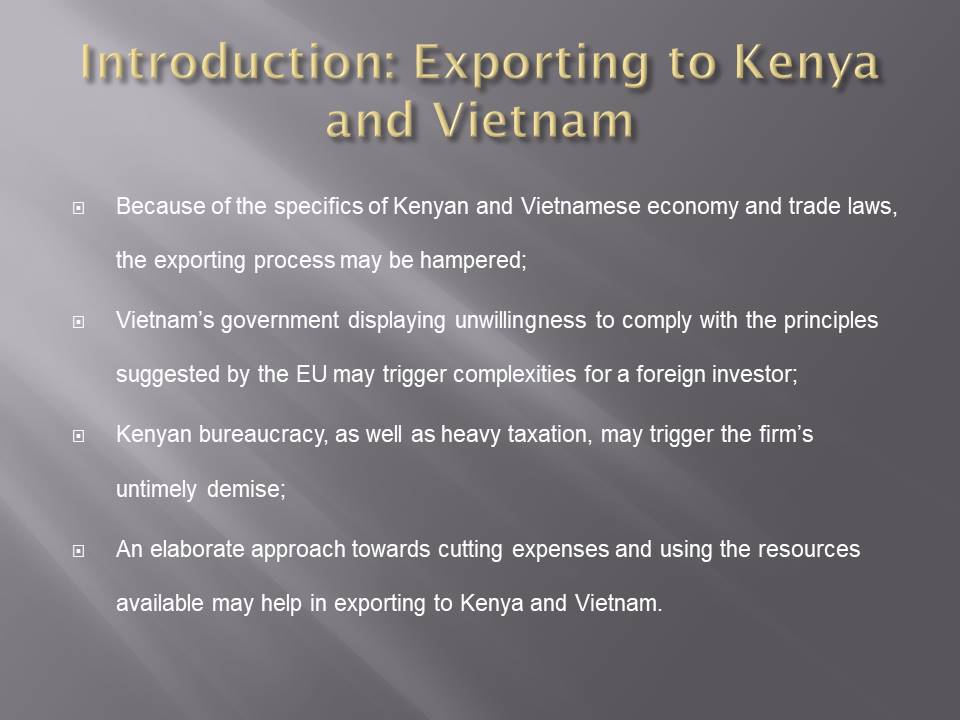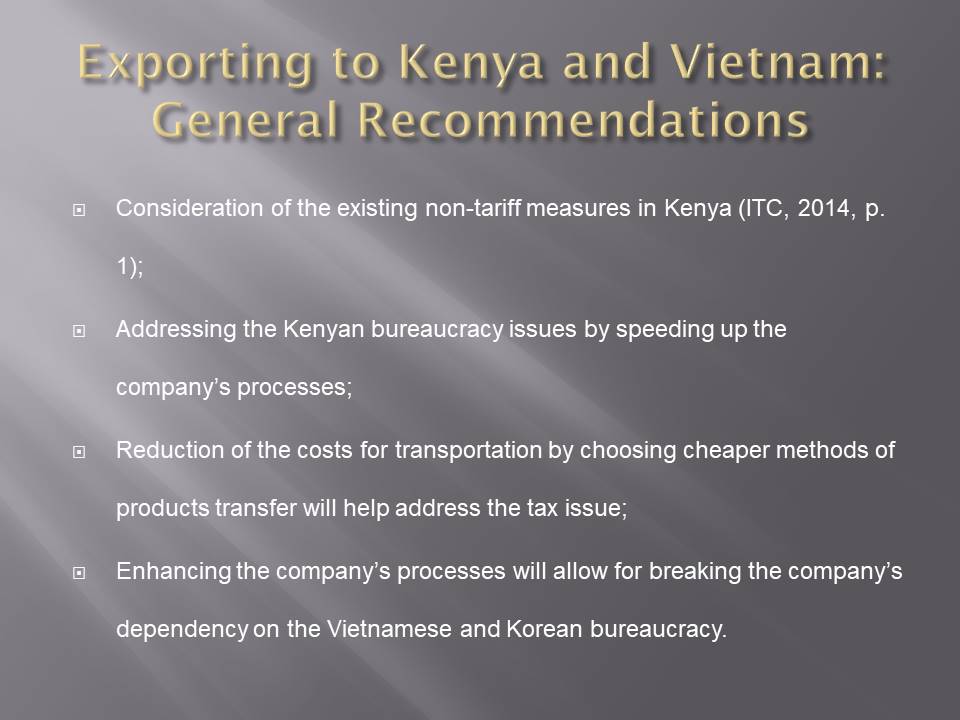Introduction: Exporting to Kenya and Vietnam
- Because of the specifics of Kenyan and Vietnamese economy and trade laws, the exporting process may be hampered;
- Vietnam’s government displaying unwillingness to comply with the principles suggested by the EU may trigger complexities for a foreign investor;
- Kenyan bureaucracy, as well as heavy taxation, may trigger the firm’s untimely demise;
- An elaborate approach towards cutting expenses and using the resources available may help in exporting to Kenya and Vietnam.

Importing Policies in Kenya
As a member of EAC (East African Community), Kenya complies with the rules and regulations thereof. Kenya’s GDP is the largest in South East and Central Africa (Exporting to Kenya, 2014).
Taxes in Kenya
- income tax;
- customs and excise duties;
- Value Added Tax (VAT);
- personal income tax;
- corporate tax (Exporting to Kenya, 2014).
PVoC Programme
- Physical inspection, sampling, audits, documentary checks, standards assessment (Kenya Bureau of Standards, 2015).

Kenya: Tariffs and Restrictions
Tariffs + Restrictions
- The EAC Common External Tariff (CET);
- Export labeled as trade diversion (Frazer, 2012, p. 8);
- Administrative procedures (Tanzania Chamber of Commerce, Industry and Agriculture, n. d.).
Solutions
- Locating the existing non-tariff solutions (NTM) (Frazer, 2012);
- Enhancing the positive effects of the products exported on the state economy;
- Speeding the company’s processes up.
Importing Policies in Vietnam
Vietnam is about to sign agreement with the European Union . The so-called grey areas of the Vietnamese law, however, may impede the process of exporting goods to the country (Exporting to Vietnam, 2014).
Taxes in Vietnam
- CIT, VAT, SST;
- Foreign contractors tax
Free Trade Agreements (FTAs)
- China
- Japan
- South Korea
- India
- Australia
- New Zealand (Exporting to Vietnam, 2014).


Vietnam: Tariffs and Restrictions
Tariffs + Restrictions
- 0% import tariff (European Commission, 2015);
- Registration and custom procedures;
- Price control on certain products;
- Lack of organizations open for foreign investments
Solutions
- Reduction of costs for other issues;
- Proper registration arrangements;
- Introduction of additional options for customers;
- Adequate search instruments.

Exporting to Kenya and Vietnam: General Recommendations
- Consideration of the existing non-tariff measures in Kenya (ITC, 2014, p. 1);
- Addressing the Kenyan bureaucracy issues by speeding up the company’s processes;
- Reduction of the costs for transportation by choosing cheaper methods of products transfer will help address the tax issue;
- Enhancing the company’s processes will allow for breaking the company’s dependency on the Vietnamese and Korean bureaucracy.

Reference List
European Commission. (2014). Barrier Fisher result. Web.
Exporting to Kenya. (2014). UK trade and investment. Web.
Exporting to Vietnam. (2014). UK trade and investment. Web.
Frazer, G. (2012). The EAC Common External Tariff (CET) and Rwanda.International Growth Centre. Web.
ITC. (2014). Introduction to non-tariff measures. Kenya: Company perspectives (pp. 3-4). Geneva, SW: ITC.
Kenya Bureau of Standards. (2015). Detailed exporter and importer guidelines. Web.
Tanzania Chamber of Commerce, Industry and Agriculture. (n. d.). Top 5 non tariff barriers in Tanzania (originating from Tanzania or other EAC countries but affecting Tanzania). TCCIA. Web.